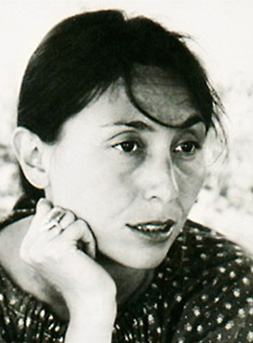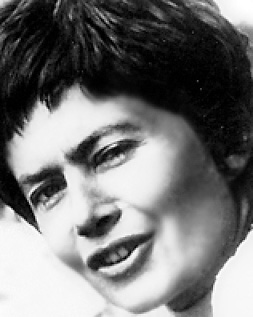Gender and the Human:
Luce Irigaray and Julia Kristeva, a reflection
Both Irigaray and Kristeva have focussed on the formation and development of the foetus within the body of the mother, considering the foetus as an 'other' (neither is interested at this point in the gender of the developing life) which nevertheless coexists with the mother. For both Irigaray and Kristeva there are important processes here which are not by any means mere 'analogies' of the 'self-other' relationship (although the processes do function as analogies too) but which also need to be understood biologically or physiologically in their own right.
Irigaray focuses on the role of the placenta. This is tissue which belongs, strictly speaking, neither to the mother nor to the foetus. Its role is to mediate between the two.
Kristeva focuses on the chorion. This is the envelope of tissue which surrounds the growing foetus. The role of the chorion on which Kristeva focuses is one of signalling: it is the chorion which stimulates the production of human chorionic gonadotrophin, the hormone which inhibits menstruation and thereby prevents the foetus being lost.
For both writers, the growth of the foetus in the body of the mother clearly is an important focus because it fills out the often simplistic observation that 'all people, male or female, come into the world through the body of a woman'. While this basic observation clearly has some value in restraining simplistic notions of the masculine, preventing a crude chauvinism from aspiring to some sort of independence of the feminine, it is also easily countered by the simplistic observation that the procreation is dependent on a male initiating the process. By moving the centre of attention to the period of gestation and foetal development not only is the proportionality between male and female roles in procreation emphasised, but attention is also directed to physiological, and particularly hormonal processes which uniquely tie the new life to the body of the mother. These ties will remain, albeit invisibly, for the rest of the new individual's life, as permanently coded into its own biology (and perhaps mind) as is the DNA it has acquired from both parents.
However, apart from the two writers' focus on different aspects of developmental physiology, there is a huge contrast between their intent, and this points clearly to the different intentions of the whole body of work for each writer.
For Irigaray, the central aim is always to establish what she variously describes as a 'sexed' culture, or a culture of 'difference', or a 'je-tu' ('I-you' but with a connotation of intimacy or relationship as well as of separateness) culture. This is a culture in which the female subject stands on an equal footing with the male subject as both an 'I' and a 'you'. To achieve such a culture will require major transformations of language (to eliminate pro-male gender bias) of global female subjectivity, so that women's identity as full, sexed subjectivities is not in any sense subordinated (in their own minds, that is) to male subjectivities, and of course to political, legal and economic processes and institutions, so that mechanisms of subjugation are fully eliminated.
For Kristeva, the central aim is an understanding of the meaning subject and of the process of signification; it could be considered as a concern with understanding texts, or how we read and make them, with the proviso that 'text' is seen as a phenomenon in all cultural spheres, not simply that of literature or alphabetic language.
Where such capsule summaries of the programs of major theorists are doomed to failure, we need to consider their method. At this point Kristeva and Irigaray diverge even more markedly. Both write polemic, and both operate over a wide range of traditional disciplines, but Kristeva's work, unlike Irigaray's, is self-consciously within the Western intellectual mainstream, which I would characterise as an ongoing exegesis of a broad academic canon straddling disciplines such as philosophy, linguistics, history, politics and perhaps psychology (some would say psychoanalysis). The major theorists (to identify the major figures: Freud, Husserl, Frege ... through to Lacan, Derrida and Barthes) - primarily male - whom Kristeva reads and in dialogue with whom she articulates her own emerging views, represent a tradition within-and-against which she thinks, whereas for Irigaray they clearly represent a tradition against which she thinks but which she is not willing to stand within; indeed, for Irigaray, to stand apart from this tradition seems essential to her enterprise.
For both Irigaray and Kristeva, then, central aim and characteristic method exactly coincide; for Irigaray, sexed difference is the central preoccupation, for Kristeva, the central dialectic is that between the signifying subject and the signified.
To characterise this in terms which are more freely my own, I would state, simplistically, that for Irigaray genderedness is primary, while for Kristeva, some such category as the 'human' is primary. 'Human' is the word I prefer, although it inevitably enters the discussion as something of a loaded weapon. As an alternative articulation, then, and one which provides a connection with my own theologised enterprise, I find it useful to consider a short text from Genesis which comes at the end of the second of the two main creation narratives provided by the opening chapters of the book (the second narrative being the one which foregrounds issues of gender). Translation, at this point, is difficult (Genesis has a history of particularly bad translation into English, even by the remarkably low ... that is to say, literary ... standards evident in the Old Testament as a whole). Apart from the obvious issues of gender, Old Testament translation suffers from a tradition of 'ennobling' or 'gentrification' whereby the language has been remorselessly pushed into higher registers than the Hebrew warrants.
Therefore I use here, in place of the traditional 'man' or 'Adam', my own term 'Earth-child'. The Hebrew adam, translated traditionally by either 'man' or 'Adam' according to context, means, literally, 'from the earth'. While 'Earth-child' has an unavoidably sci-fi connotation, the word 'earth' is preferable to 'dust' (no connotation of fruitfulness), 'ground' (good in the sense of 'both feet on the ground' but otherwise too predominantly positional), or 'soil' (good in the sense of fruitfulness, but with too strong a connotation of 'dirt'). I have also chosen to simply let the Hebrew ish and ishah (man and woman) stand as they are: just as 'woman' carries the word 'man' within it, and 'female' carries the word 'male within it, preventing either from standing fully against its opposite, so 'ishah' can be seen as simply the masculine 'ish' with the typical feminine 'ah' suffix transforming its gender. Ish and ishah have, however, the virtue of relative strangeness to European ears and eyes.
So Genesis talks of 'the days of the earth when God made the earth-child: ish and ishah God made them'.
The parallelism of the two phrases is clear, and in this the line conforms to traditional Hebraic poetic patterning. What is striking about the line is the deliberate ambiguity of the earth child: it is both an 'it' (singular) and a 'them' (plural). As a poetic device, this is being used to assert, I would argue, a fundamental ontological duality. It is also worth noting that the Genesis creation narratives considered as a unit (say, the first six or nine chapters together) conduct a similar exercise in deliberate ambiguity with the word 'yom' and 'yomim' ('day' and 'days') as if to assert both the particularity of time, and its expansive capacity. So, while it is easy to show that biblical traditionalists who insist that Genesis talks of 'standard 24-hour days' of creation are crudely misreading the text, precisely the same exegesis demonstrates that to regard time in Genesis as purely a matter of vague 'eras' is equally simplistic. I have two points here which I regard as of relevance to gender theory: firstly, the Judeao-Christian tradition, which is much-implicated in a range of cultural crimes of the last few millennia, actually posits a remarkably flexible ontology and one which does not fit comfortably with the dominant Western / classical tradition (in which Aristotle's principle of non-contradiction is canonical). Second, that time, in the Judaeo-Christian tradition, sits in a curious position relative to what we might call History.
History, for both Irigaray and Kristeva, is primarly 'the' History in what we might call a traditionally Hegelian, World-Historical sense. It is a dialectic of change, which moves in eras or phases each of which has its own Spirit and its own typical set of paradigms. This is a conception of History which, in many commentaries on Hegel's thought, for instance, has often been noted as having a natural affinity with theologised History in the Judaeo-Christian tradition. Outside of this particularly European theoretical context, however, and evidenced by the continuing often hostile reception of Hegelian thought particularly in English-speaking intellectual cultures, a more 'positivist' and particulate conception of history continues to be influential; a conception of history which is seen as less driven by inevitabilities, and more the result of individual decisions and accidents; which is to be understood by a focus on discrete factualities and the search for specific crises, moments, or localised determinations. This particulate conception of history can be seen not only in old-style 'dates and places' history - historiographically and hermeneutically naive - but also in Annales-style history, which is theoretically aware and hermeneutically sophisticated.
My own understanding of the nude has given me a concern to hold both these conceptions of History together, since I regard it as essential to consider not only the theoretical issues which preoccupy both Kristeva and Irigaray (as, of course, they preoccupy many other writers) but also to give due weight to the 'akwardness' of particulate history, by which I mean the stubbornness one always finds in working on specific historic events, individuals or texts whereby they twist constantly out of the grip of the categories within which we seek to understand them. This intractability of the human is something which, at the level of the individual life, is actually to be celebrated. As particulate history, however (that is, particulate, but also part of a wider historical context) it serves as a counter to any kind of reductionism, reminding us that any theory which cannot accommodate contradiction is inherently weak.
So, to return briefly to my own central concerns, I understand the nude as intrinsically both erotic and non-erotic; agonistic and domestic, confrontational and eirenic. I understand both the male gaze and the female as both intrusive and invited, as both gendered and human.
And, to summarise my reading of Irigaray and Kristeva on these issues, I find Kristeva ultimately the more satisfying, since in Irigaray the human, the 'earth-childness' is constantly made secondary to gendered or, to use Irigaray's own term, 'sexuate' subjectivity. That is to say, for Irigaray difference is posited as primary to, rather than covalent with humanity.
Harry Smart, October 2003
Bibliography
Irigaray, Luce & Whitford, Margaret, 1991, The Irigaray Reader, Oxford, Blackwell.
Irigaray, Luce, 1993, Je, tu, nous: towards a culture of difference, London: Routledge.
Irigaray, Luce, 2000, To Be Two, London: Athlone Press. Originally published as Essere Due, 1994.
Kristeva, Julia & Moi, Toril, 1986, The Kristeva Reader, Oxford, Blackwell.

